7 tragically abandoned cities of the 20th century (23 pics + text)
 Bashny.Net
Bashny.Net
Nothing is forever, sooner or later becomes unnecessary, matches and files, tires and shoes, cars and factories. Entire cities are dying, leaving the stone skeletons on pickings looters or fun tour. So it was, is and will be, in every century has its Pompeii and Klondikes.

1. The island of Hashima (Hashima)
- One of the most unique desert islands of Japan. Almost the entire area of the island occupies abandoned ghost town Hashim. Surprisingly, there was not any man-made disasters or epidemics. Thriving city with an ever-growing houses and buildings are simply left after the stockpiles of coal mines dried up.
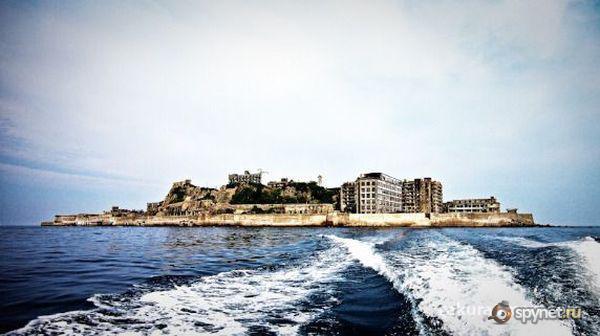
Coal mines, like water for a living organism, fueled life in the city, given the income and jobs, but after the development of the coal mine stopped life in the city and its residents began to leave. In 1974, Hashim turned into a ghost town - it completely left the people, but we have a unique opportunity to see what happens in 35 years after "disappearing" people.
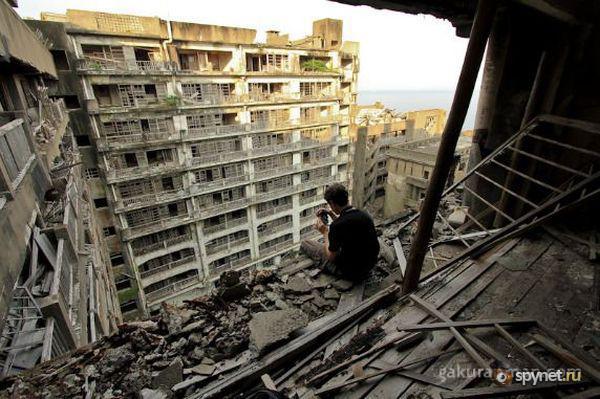
At the moment, visiting the island is prohibited. So the Japanese government tried to protect the island from the "black diggers" - objects of everyday life from the dead city are hunted wealthy collectors.
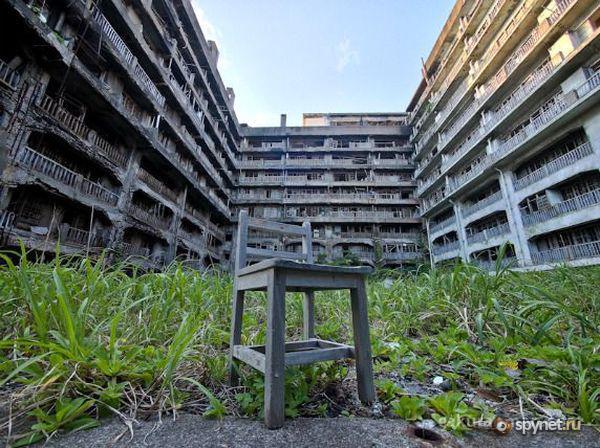
Now to get to the city Hashim only by private boat or boat. But it is illegal in Japan! It is made specifically to protect the city from the "barbarians" stealing household items and construction crumbling ghost town.
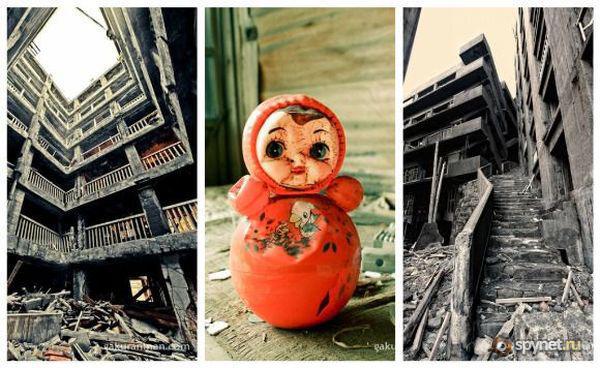
2. Deception Island, Antarctica
Probably, Antarctica - a continent with the largest number of abandoned settlements per capita. Many thanks to this I must say the climate and the persistent desire of man to settle down in this godforsaken continent. Insistence person to settle in this harsh continent caused not only scientific, but also political interests.
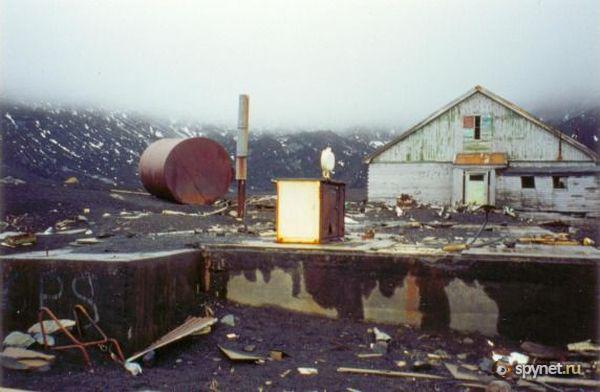
There is even a hangar for aircraft.
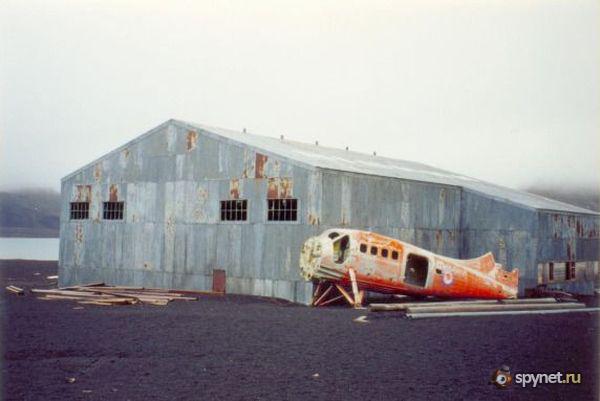
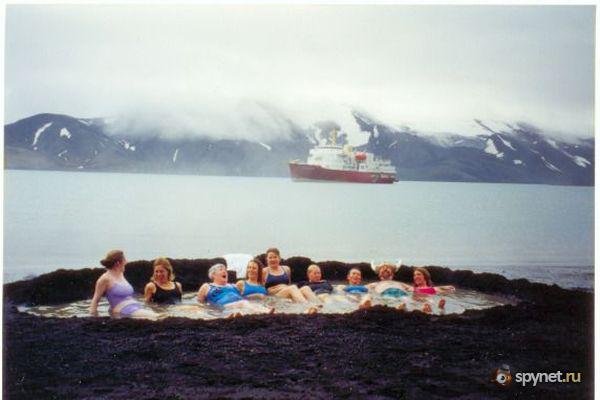
3. Centralia (Pennsylvania)
The town, located in Pennsylvania, USA. Because erupted 48 years ago, the underground fire, the number of inhabitants has decreased from 1 000 (1981) to 12 (2005), since 2007 resides 9 people. Centralia is now considered the least populous city in the state of Pennsylvania.

Here, walking on the wide asphalt road along the meager belts and stunted plants can turn in an instant on the threshold of Hell itself. Way asunder beneath you, chadyaschie thick smoke fills the air around the stench of burning garbage. But you're wrong, suggesting that here dwells the devil himself. And it all started so well ... in this inconspicuous area first, there was a small eatery. Fussed around her people by developing active life. Gradually there were streets and streets, grown at home. Behind the Scenes of the inhabitants called their town Tsentrvilem. But when there is mail - it turned out that Tsentrvil already exists. Sighing, changed its name to citizens consonant - Centralia. Life in the town went on as usual, people are looking for entertainment in theaters, showrooms, stores and cafes. But malomalski fame brought Centralia coal and anthracite industry, we are found some good deposits have built a network of mines. However, after a few years the mines closed, the field seemed to have exhausted itself, and investors felt that invest in the further development of the industry Centralia - it rotten.
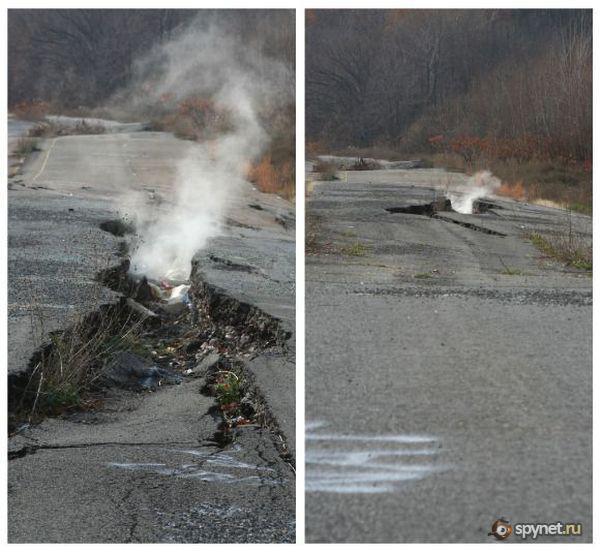
4. Kolmanskop (Kolmanskuppe), Namibia
Kolmanskop - a ghost town in southern Namibia, from the coast and up to several kilometers inland. Kolmanskop was founded during the diamond rush in Namibia in 1908 in the desert, 10 kilometers from Luderitz and the Atlantic Ocean. In Kolmanskop they were built big beautiful house, school, hospital, stadium. For several years, both from the ground up a model German town. Residents were counting on a long prosperity in the diamond city. Indeed, in this desolate corner of the diamond it was so much that the workers were crawling on his stomach and easily raked them with a brush in a scoop. Perhaps migrants something offended the local deities. Or maybe just born under an unlucky star. But the flow of diamonds quickly dried up, and as soon as started to dig deeper, it became clear that, alas, is no ultimate treasure in the Namibian soil is not expected. Inventories of diamonds virtually limited to the first diamond found in the sand. Then it became clear that to live in this town hard, and no reason: sandstorms, lack of drinking water. And ten years after the founding of a mass exodus of the local inhabitants. Since Kolmanskop well worth the amazing ghost town in the middle of the desert sand. Most of the houses are almost entirely covered with sand, and produces more depressing spectacle. In 1980 the building was restored and Kolmanskop gained a new life, but now as a museum.
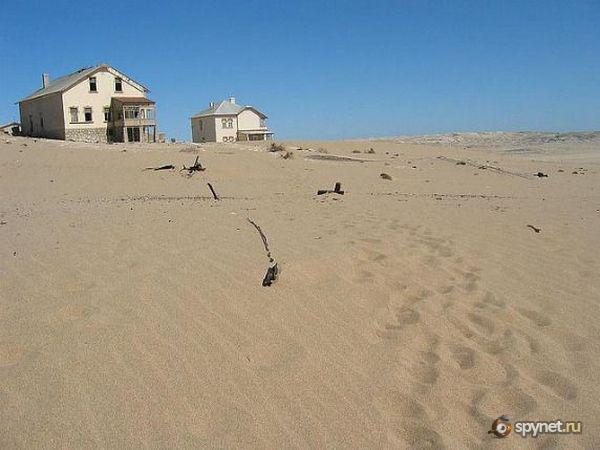
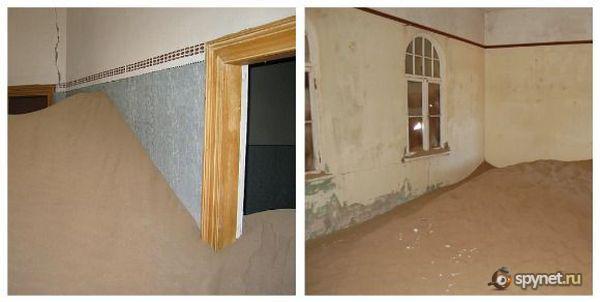
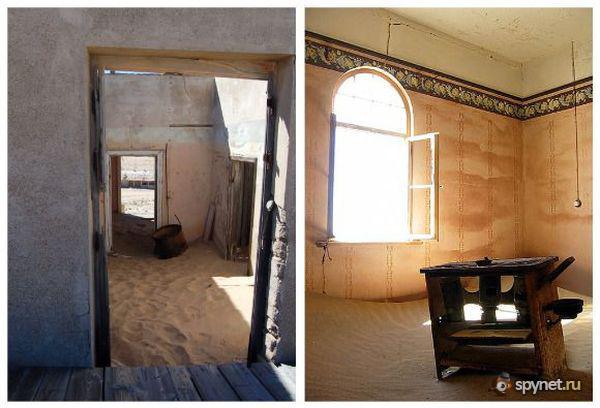
5. Quneitra, Syria
It leaves the city in southwestern Syria under UN administration, the capital of the province of Quneitra. In 1967, after the Six Day War, the city withdrew to Israel. During the Yom Kippur War in 1973, the city re-entered Syrian troops. In Quneitra concentrated half of all Syrian military power. October 21 the same year the city was fierce bombardment of the Israeli Air Force. This was followed by a ground operation, during which the Quneitra was completely destroyed. Before the war, the Israeli army after the capture of the city managed to move into Syrian territory, so that was at a distance of about 40 kilometers from Damascus. In May 1974 at the initiative of the United States between Israel and Syria signed a disengagement agreement by which territories occupied by Israel has been transformed into a demilitarized buffer zone under UN administration. The region was a state of emergency the armed forces and the UN forces established Disengagement Observer Force. Until 1973 the city population was 17,000 people. Quneitra was returned to Syria by the known "Agreement on the division of power between Israel and Syria," on May 31, 1974, initiated by the United States, where in paragraph B (1) written requirement: All territory east of Line A will be subject to the Syrian administration, and Syrian citizens return to the area & quot ;.
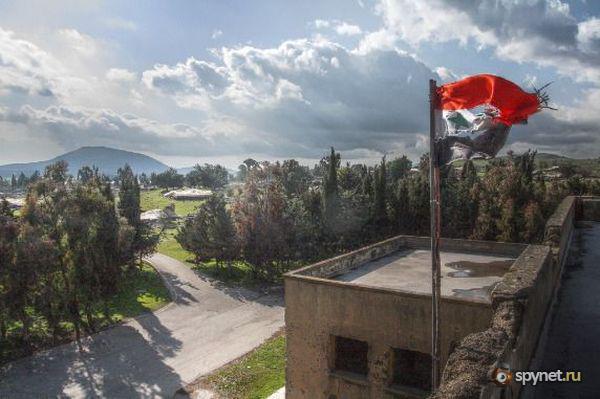
Special Representative of the Secretary-General of the United Nations Nils-Goran Gussing visited Quneitra in July and reported that "almost every store and every house seemed to have been broken into and looted," and that some buildings were set on fire after they were skinned. While Israeli officials told Gussing that Quneitra was looted by retreating Syrians, the representative of the United Nations regards it as unlikely, given the very short time between the erroneous announcement on the radio about the fall and the real fall of the city a few hours later. He concluded that "the responsibility for the implementation of this extensive looting of the city of Quneitra lay heavily on Israeli forces." [3] The US Committee for Refugees and Immigrants reported that: "Before the departure of the Israelis leveled the city with the help of bulldozers and dynamite. "[4] Since 1974, Quneitra is in neutral demilitarizovanoy strip between the Israeli and Syrian border controlled by UN forces. The town remains virtually uninhabited until now.
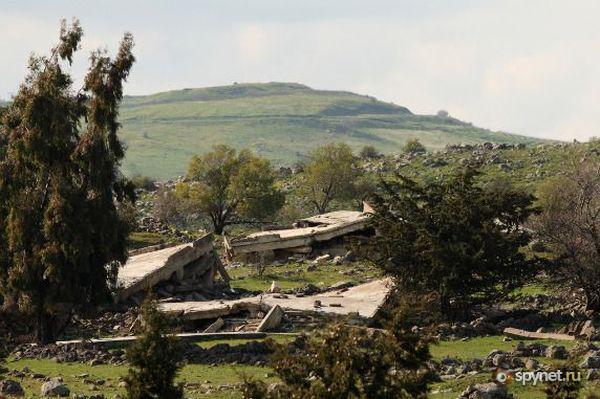
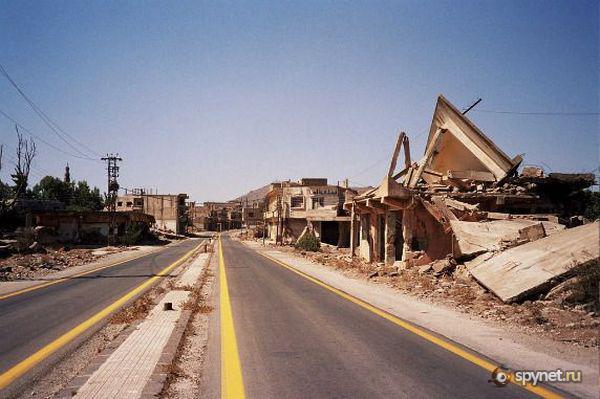

6. Pripyat, Ukraine
A special theme - closed cities, victims of man-made accidents, which are the first in the list appears Pripyat. The explosion in the mine served as a formal pretext for settling Kadykchan, undermine the city in search of brown coal shook the fate of the Italian town of Castelnuovo, which allowed the filmmakers to turn empty houses into the scenery for the film about the life of the insane.
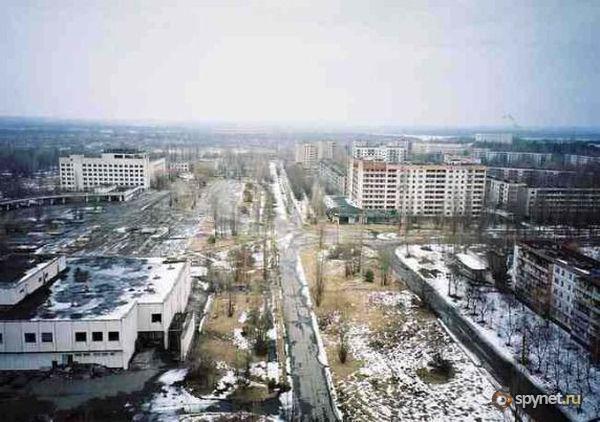
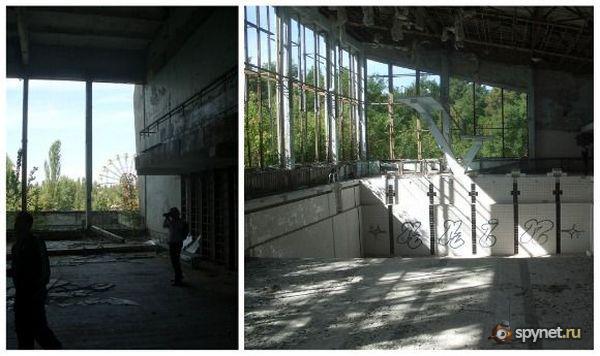
7. San Chi, Taiwan
Taiwanese resort of San Chi was built in the 1970s in a deliberate cosmic style in complex technologies, which were beyond the power of a variety of workers. Therefore, at the construction site of fatal PE was missing. Ambitious plans of developers put an end to the credit crisis of the early 80s, and then the miracle house San Chi decided to dismantle and ... deaths resumed. Superstitious Chinese decided not to anger the fate and left it at that.
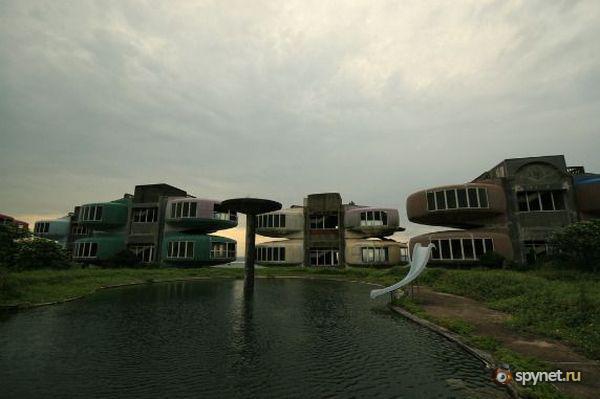
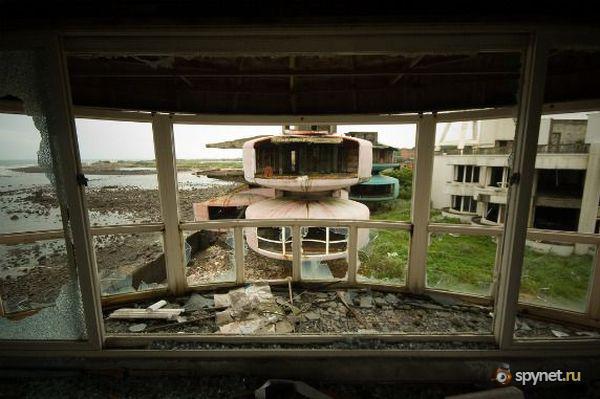
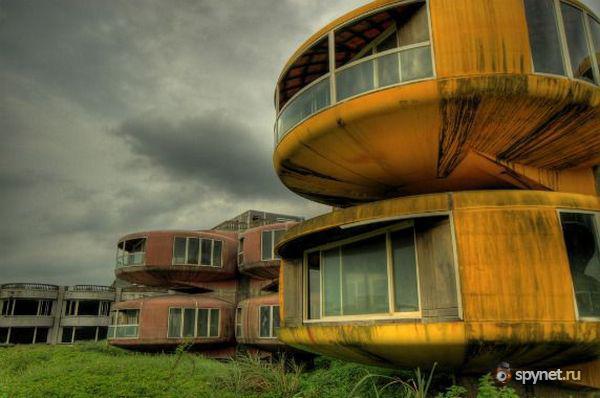
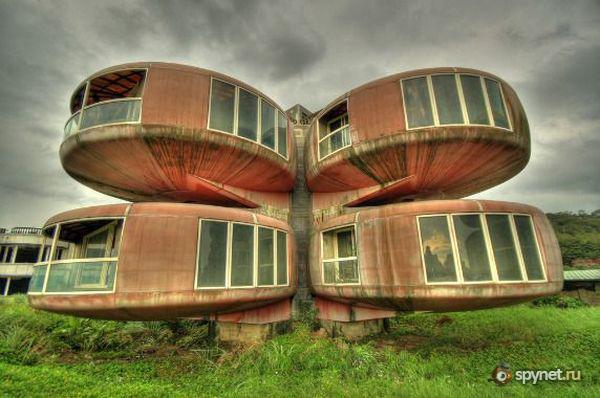
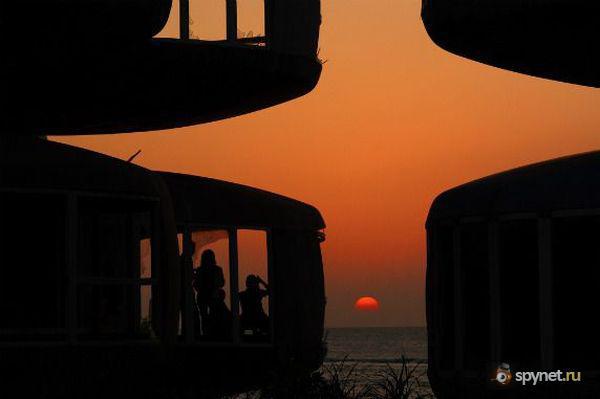

1. The island of Hashima (Hashima)
- One of the most unique desert islands of Japan. Almost the entire area of the island occupies abandoned ghost town Hashim. Surprisingly, there was not any man-made disasters or epidemics. Thriving city with an ever-growing houses and buildings are simply left after the stockpiles of coal mines dried up.

Coal mines, like water for a living organism, fueled life in the city, given the income and jobs, but after the development of the coal mine stopped life in the city and its residents began to leave. In 1974, Hashim turned into a ghost town - it completely left the people, but we have a unique opportunity to see what happens in 35 years after "disappearing" people.

At the moment, visiting the island is prohibited. So the Japanese government tried to protect the island from the "black diggers" - objects of everyday life from the dead city are hunted wealthy collectors.

Now to get to the city Hashim only by private boat or boat. But it is illegal in Japan! It is made specifically to protect the city from the "barbarians" stealing household items and construction crumbling ghost town.

2. Deception Island, Antarctica
Probably, Antarctica - a continent with the largest number of abandoned settlements per capita. Many thanks to this I must say the climate and the persistent desire of man to settle down in this godforsaken continent. Insistence person to settle in this harsh continent caused not only scientific, but also political interests.

There is even a hangar for aircraft.


3. Centralia (Pennsylvania)
The town, located in Pennsylvania, USA. Because erupted 48 years ago, the underground fire, the number of inhabitants has decreased from 1 000 (1981) to 12 (2005), since 2007 resides 9 people. Centralia is now considered the least populous city in the state of Pennsylvania.

Here, walking on the wide asphalt road along the meager belts and stunted plants can turn in an instant on the threshold of Hell itself. Way asunder beneath you, chadyaschie thick smoke fills the air around the stench of burning garbage. But you're wrong, suggesting that here dwells the devil himself. And it all started so well ... in this inconspicuous area first, there was a small eatery. Fussed around her people by developing active life. Gradually there were streets and streets, grown at home. Behind the Scenes of the inhabitants called their town Tsentrvilem. But when there is mail - it turned out that Tsentrvil already exists. Sighing, changed its name to citizens consonant - Centralia. Life in the town went on as usual, people are looking for entertainment in theaters, showrooms, stores and cafes. But malomalski fame brought Centralia coal and anthracite industry, we are found some good deposits have built a network of mines. However, after a few years the mines closed, the field seemed to have exhausted itself, and investors felt that invest in the further development of the industry Centralia - it rotten.

4. Kolmanskop (Kolmanskuppe), Namibia
Kolmanskop - a ghost town in southern Namibia, from the coast and up to several kilometers inland. Kolmanskop was founded during the diamond rush in Namibia in 1908 in the desert, 10 kilometers from Luderitz and the Atlantic Ocean. In Kolmanskop they were built big beautiful house, school, hospital, stadium. For several years, both from the ground up a model German town. Residents were counting on a long prosperity in the diamond city. Indeed, in this desolate corner of the diamond it was so much that the workers were crawling on his stomach and easily raked them with a brush in a scoop. Perhaps migrants something offended the local deities. Or maybe just born under an unlucky star. But the flow of diamonds quickly dried up, and as soon as started to dig deeper, it became clear that, alas, is no ultimate treasure in the Namibian soil is not expected. Inventories of diamonds virtually limited to the first diamond found in the sand. Then it became clear that to live in this town hard, and no reason: sandstorms, lack of drinking water. And ten years after the founding of a mass exodus of the local inhabitants. Since Kolmanskop well worth the amazing ghost town in the middle of the desert sand. Most of the houses are almost entirely covered with sand, and produces more depressing spectacle. In 1980 the building was restored and Kolmanskop gained a new life, but now as a museum.



5. Quneitra, Syria
It leaves the city in southwestern Syria under UN administration, the capital of the province of Quneitra. In 1967, after the Six Day War, the city withdrew to Israel. During the Yom Kippur War in 1973, the city re-entered Syrian troops. In Quneitra concentrated half of all Syrian military power. October 21 the same year the city was fierce bombardment of the Israeli Air Force. This was followed by a ground operation, during which the Quneitra was completely destroyed. Before the war, the Israeli army after the capture of the city managed to move into Syrian territory, so that was at a distance of about 40 kilometers from Damascus. In May 1974 at the initiative of the United States between Israel and Syria signed a disengagement agreement by which territories occupied by Israel has been transformed into a demilitarized buffer zone under UN administration. The region was a state of emergency the armed forces and the UN forces established Disengagement Observer Force. Until 1973 the city population was 17,000 people. Quneitra was returned to Syria by the known "Agreement on the division of power between Israel and Syria," on May 31, 1974, initiated by the United States, where in paragraph B (1) written requirement: All territory east of Line A will be subject to the Syrian administration, and Syrian citizens return to the area & quot ;.

Special Representative of the Secretary-General of the United Nations Nils-Goran Gussing visited Quneitra in July and reported that "almost every store and every house seemed to have been broken into and looted," and that some buildings were set on fire after they were skinned. While Israeli officials told Gussing that Quneitra was looted by retreating Syrians, the representative of the United Nations regards it as unlikely, given the very short time between the erroneous announcement on the radio about the fall and the real fall of the city a few hours later. He concluded that "the responsibility for the implementation of this extensive looting of the city of Quneitra lay heavily on Israeli forces." [3] The US Committee for Refugees and Immigrants reported that: "Before the departure of the Israelis leveled the city with the help of bulldozers and dynamite. "[4] Since 1974, Quneitra is in neutral demilitarizovanoy strip between the Israeli and Syrian border controlled by UN forces. The town remains virtually uninhabited until now.



6. Pripyat, Ukraine
A special theme - closed cities, victims of man-made accidents, which are the first in the list appears Pripyat. The explosion in the mine served as a formal pretext for settling Kadykchan, undermine the city in search of brown coal shook the fate of the Italian town of Castelnuovo, which allowed the filmmakers to turn empty houses into the scenery for the film about the life of the insane.


7. San Chi, Taiwan
Taiwanese resort of San Chi was built in the 1970s in a deliberate cosmic style in complex technologies, which were beyond the power of a variety of workers. Therefore, at the construction site of fatal PE was missing. Ambitious plans of developers put an end to the credit crisis of the early 80s, and then the miracle house San Chi decided to dismantle and ... deaths resumed. Superstitious Chinese decided not to anger the fate and left it at that.





Tags
See also
Ghost Town in the desert, Namibia (12 pics + text)
Ghostly statue abandoned city (6 photos)
Ghost Town in the forest
Island of Montserrat
Waste cities (9 photos + text)
Summer camp "Forest gave"
City on the rocks
Abandoned objects of the world. Part 28. (23 photos)
Ghost towns in the territory of the former USSR
Abandoned objects of the world. Part 30. (20 photos)

















